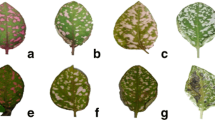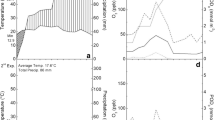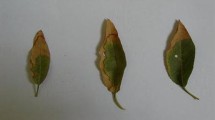Abstract
A method for the numerical assessment of the foliar injury caused by the photochemical oxidant, peroxyacetyl nitrate (PAN), was devised, using three injury indices: fresh weight (FW) loss, decreased photosynthetic pigment content, and increased ion leakage, which can be measured using the same leaves. The injury indices clearly indicated a larger number of PAN-sensitive leaves and a more severe level of injury in the PAN-sensitive variety of Petunia hybrida, White Champion (WHITE), compared to the PAN-tolerant variety, Blue Champion (BLUE). FW and photosynthetic pigment content decreased correlatively in both varieties, but ion leakage increased only in WHITE. Morphological observations revealed that ion leakage started concurrently with the start of plasmolysis-like symptoms at the mesophyll cells of injured WHITE leaves, whereas FW loss corresponded to the shrinkage of cells without loss of their round shape in BLUE leaves. PAN injuries measured by the injury indices were markedly increased in the presence of light, and the morphological changes following PAN exposure were similar to those caused by the superoxide-generating chemical, paraquat. The results suggested that PAN injuries indicated by the three injury indices are all light-dependent, but are caused through several independent mechanisms.









Similar content being viewed by others
References
Aono M, Kubo A, Saji H, Natori T, Tanaka K, Kondo N (1991) Resistance to active oxygen toxicity of transgenic Nicotiana tabacum that expresses the gene for glutathione reductase from Escherichia coli. Plant Cell Physiol 32:691–697
Chimiklis PE, Heath RL (1975) Ozone-induced loss of intracellular potassium ion from Chlorella sorokiniana. Plant Physiol 56:723–727
Conference on Agricultural Technology in Chiba (1996) Photograph album of injury on crop plants (in Japanese)
Dugger WM, Taylor OC Jr, Cardiff E, Thompson CR (1962) Stomatal activity in plants related to damage from photochemical oxidants. Plant Physiol 37:487–491
Gaffney JS, Fajer R, Senum GI (1984) An improved procedure for high purity gaseous peroxyacetyl nitrate production: use of heavy lipid solvents. Atmos Environ 18:215–218
Glater RB, Sorberg RA, Scott FM (1962) A developmental study of the leaves of Nicotiana glutinosa as related to their smog-sensitivity. Am J Bot 49:954–970
Hill AC, Pack MR, Treshow M, Downs RJ, Transtrum LG (1961) Plant injury induced by ozone. Phytopathology 51:356–363
Kirk JTO, Allen RL (1965) Dependence of chloroplast pigment synthesis on protein syntheses: effect of actidine. Biochem Biophys Res Commun 21:523–530
Konno S, Okita T (1974) Determination of peroxyacetyl (PAN) produced in the atmosphere or in a photochemical reaction chamber. I. Res Rep Inst Public Health 23:50–58
Liu GY, Chen KJ, Lin-Shiau SY, Lin JK (1999) Peroxyacetyl nitrate-induced apoptosis through generation of reactive oxygen species in HL-60 cells. Mol Carcinog 25:196–206
Mackinney G (1941) Absorption of light by chlorophyll solutions. J Biol Chem 140:315–322
Nouchi I, Toyama S (1988a) Effects of ozone and peroxyacetyl nitrate on polar lipids and fatty acids in leaves of morning glory and kidney beans. Plant Physiol 87:638–646
Nouchi I, Toyama S (1988b) Leaf injury of plants and mechanism of injury by photochemical oxidants (ozone and peroxyacetyl nitrate) Bull Nat Inst Agro-Environ Sci 5:1–121
Nouchi I, Iijima T, Sawada M, Oohira T (1975) The effect of peroxyacetyl nitrate (PAN) on plants. Annu Rep Tokyo Metrop Inst Environ Sci 6:113–120
Okano K, Tobe K, Furukawa A (1990) Foliar uptake of peroxyacetyl nitrate (PAN) by herbaceous species varying in susceptibility to this pollutant. New Phytol 114:139–145
Oohashi T, Suga K, Matsumura H (1989) Exposure of petunia to PAN in an outdoor chamber (in Japanese). Annual Report of the Tokyo Metropolitan Research Institute for Environmental Protection, pp 89–91
Sakaki T, Kondo N, Sugahara K (1983) Breakdown of photosynthetic pigments and lipids in spinach leaves with ozone fumigation: role of active oxygens. Physiol Plant 59:28–34
Saltzman BE (1954) Colorimetric microdetermination of nitrogen dioxide in the atmosphere. Anal Chem 26:1949–1955
Shimazaki K, Sakaki T, Kondo N, Sugahara K (1980) Active oxygen participation in chlorophyll destruction and lipid peroxidation in SO2-fumigated leaves of spinach. Plant Cell Physiol 21:1193–1204
Stephens ER, Darley EF, Taylor OC, Scott WE (1961) Photochemical reaction products in air pollution. Int J Air Water Pollut 4:79–100
Taylor OC, Maclean DC (1970) Nitrogen oxides and the peroxyacetyl nitrates. In: Jacobson JS, Hill AC (eds) Recognition of air pollution injury to vegetation: a pictorial atlas. Air Pollution Control Association, Pittsburgh, pp E1–E14
Taylor OC, Dugger WM Jr, Cardif EA, Darley EF (1961) Interaction of light and atmospheric photochemical products (‘smog’) with plants. Nature 192:814–816
Thomson WW, Dugger WM Jr, Palmer RL (1965) Effects of peroxyacetyl nitrate on ultrastructure of chloroplasts. Bot Gaz 126:66–72
Treshow M (1970) Ozone damage to plants. Environ Pollut 1:155–156
Tsukaya H, Naito S, Redei GS, Komeda Y (1993) A new class of mutants in Arabidopsis thaliana, acaulis 1, affecting the development of both inflorescences and leaves. Development 118:751–764
Acknowledgements
We wish to express our gratitude to Professor S. Hasezawa of the Graduate School of Frontier Sciences, the University of Tokyo, for his encouragement and support. We would also like to extend our thanks to Professor T. Nagata of the Laboratory of Plant Physiology, the University of Tokyo, and Associate Professor Y. Takahashi of the Laboratory of Cell Biochemistry and Bioenergetics, Hiroshima University, for lending us equipment for the experiments. Our thanks also to Dr. A. Kuwabara of the Laboratory of Plant Physiology for many helpful suggestions during the course of this work, and to W.M. Oka for her helpful comments on the earlier drafts of this manuscript.
Author information
Authors and Affiliations
Corresponding author
Rights and permissions
About this article
Cite this article
Oka, E., Tagami, Y., Oohashi, T. et al. A physiological and morphological study on the injury caused by exposure to the air pollutant, peroxyacetyl nitrate (PAN), based on the quantitative assessment of the injury. J Plant Res 117, 27–36 (2004). https://doi.org/10.1007/s10265-003-0127-1
Received:
Accepted:
Published:
Issue Date:
DOI: https://doi.org/10.1007/s10265-003-0127-1




